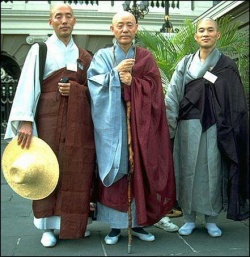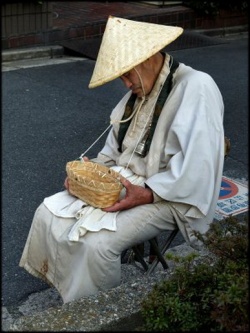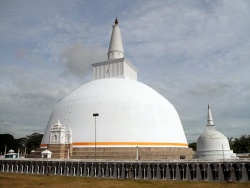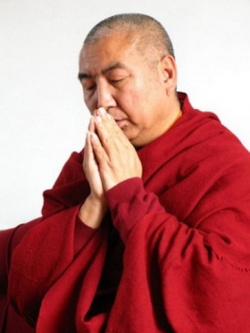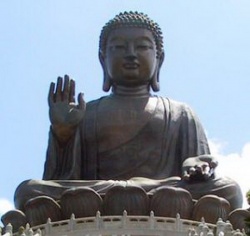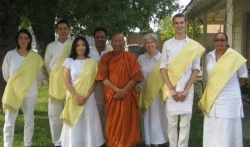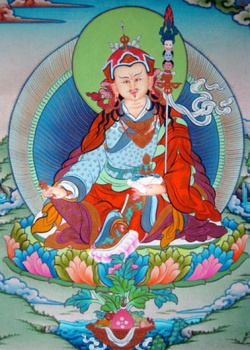The Buddhist Borderland Complex - China and India by Indrajala
The Buddhist Borderland Complex - China and India
By Indrajala (Jeffrey Kotyk)
It was in 399 CE that the Chinese monk Faxian 法顯 (338-c423), then at around the age of sixty, departed Chang'an for India accompanied by a few companions. He walked west through the treacherous Tarim Basin – a desert with sandstorms that were well-known for being lethal – and then passed over the mountains before reaching what we might call the Indosphere where Buddhism was active and flourishing. India at the time was under the rule of the Gupta Dynasty.
Faxian walked down from northern India and spent some years in various locations before heading to Sri Lanka for further study. From there he took to the sea to return to China and was nearly murdered in the process. He arrived in southern China in 414.
His stated goal for going to India at such an advanced age was to obtain Vinaya texts which were lacking in China. While he was away between 399 to 414, the Sarvāstivāda Vinaya was translated in 406 and the Dharmagupta Vinaya in 413. After returning to China Faxian together with Buddhabhadra (359-429) translated the Mahāsāṃghika Vinaya, finishing it in 418. He had obtained the original text in India and brought it back with him.[1]
Lacking a full translation of a Vinaya prātimokṣa text was imaginably humiliating for a relatively young sangha attempting to consolidate itself in a non-Buddhist land. It seems around Faxian's age the Buddhist community finally felt it essential to have a proper Vinaya system in place, which explains the motivation for Faxian's trip and the four major translation projects of Vinaya texts in the early fifth century (the Mahīśāsaka Vinaya was translated by Buddhajīva and Daosheng in 423).
In Faxian's age if one wanted to fetch texts from India it required a rather dangerous journey either through the deserts and mountains of Central Asia or on the unpredictable south seas. There was indeed traffic, particularly merchant, going both ways, though as a small group of unarmed monks the journey to India presumably required solid resolve and purpose.
In this period it seems many if not all Buddhist clerics in China saw themselves as a borderland (in Chinese bian di 邊地) realm that unfortunately lacked both Buddhadharma and adept practitioners. Although Buddhism had been introduced during the Eastern Han Dynasty (25–220 CE), a thorough canon had yet to be translated by Faxian's time. There was still a strong need to defer to Indian masters on matters of doctrine and theory. For example, there is a notable list of eighteen questions posed by Huiyuan 慧遠 (334-416) to Kumārajīva 鳩摩羅什 (344-413) preserved in the Chinese Tripiṭaka (for a discussion one section see here).[2]
Buddhism in China in Faxian's time was still in its infancy. The holy sites were all in the distant land to the west where the Buddha once walked the earth. The real masters of the tradition were not to be found in China – they were the foreign adepts, not the local monks. One can see these sentiments expressed in Faxian's travel account:
- 《高僧法顯傳》卷1:「法顯住此三年。學梵書梵語寫律。道整既到中國。見沙門法則。眾僧威儀觸事可觀。乃追歎秦土邊地眾僧戒律殘缺。誓言自今已去至得佛願不生邊地。故遂停不歸。法顯本心欲令戒律流通漢地。於是獨還。」(CBETA, T51, no. 2085, p. 864, b28-c4)
- I lived here for three years studying Sanskrit texts and the Sanskrit language while copying out the Vinaya. After Daozheng arrived in the Middle Realm [of India) he saw the śramaṇa system, observing the sangha's decorum and duty. He then thought back to China, a borderland, where the sangha is wanting with the Vinaya. He vowed that henceforth unto the attainment of Buddhahood he would not be born in a borderland. He therefore stayed and did not return. My original aspiration was to spread the Vinaya in China. Consequently I returned alone.
China as a borderland was not simply a perception on the part of Chinese monks. Faxian notes even the locals in India thought of it as such:
- 《高僧法顯傳》卷1:「過河有國名毘荼。佛法興盛兼大小乘學。見秦道人往乃大憐愍。作是言。如何邊地人能知出家為道遠求佛法。悉供給所須。待之如法。」(CBETA, T51, no. 2085, p. 859, a19-22)
- Crossing the river there is a country called *Pitu. The Buddhadharma is flourishing and they practice both the Mahāyāna and Hināyāna. Seeing monks from China they had great pity and said, “How could people of a borderland know of renunciation and practicing the path, going far in pursuit of the Buddhadharma!” They offered everything needed and looked after us accordingly.
Some of the foreign masters who went to China in the early years likewise seem to have had low estimations of the native practitioners and the land itself, at least according to the somewhat later literature. For instance, Fazang 法藏 (643–712) in his commentary on the Brahma Net Sūtra records two accounts of earlier masters who lamented the initial inability of Chinese monks to obtain bodhisattva precepts.
- 《梵網經菩薩戒本疏》卷1:「真諦三藏將菩薩律藏擬來此土。於南海上船船便欲沒。省去餘物仍猶不起。唯去律本船方得進。真諦歎曰。菩薩戒律漢土無緣。深可悲矣。又曇無讖三藏於西涼洲有沙門法進等求讖受菩薩戒。并請翻戒本。讖曰。此國人等性多狡猾又無剛節。豈有堪為菩薩道器。遂不與授。進等苦請不獲。遂於佛像前立誓。邀期苦節求戒。七日纔滿夢見彌勒。親與授戒并授戒本。並皆誦得後覺已見讖。讖覩其相異乃昌然歎曰。漢土亦有人矣。即與譯出戒本一卷。與進夢誦文義扶同。」(CBETA, T40, no. 1813, p. 605, a21-b3)
- Tripiṭaka Master Paramārtha [499-569] planned to bring the bodhisattva vinaya canon to this land. While on a ship on the south seas the ship was about to sink. They threw away other items, but still [the ship] did not rise. It was only when the threw away the Vinaya that the ship could then go on. Paramārtha lamented, “China has not the conditions for the bodhisattva Vinaya. It is deeply lamentable!” Also, Tripiṭaka Master Dharmakṣema [385-433] was in Western Liangzhou when some śramaṇa-s including Fajin sought him out to receive the bodhisattva precepts while requesting that he translate the prātimokṣa text. Dharmakṣema said, “The people of this country have much guile in their nature and further lack solid integrity. How could they be vessels for the bodhisattva path?” He was thus unwilling to confer them. Fajin and the others were unsuccessful in their painstaking requests. Thus they went before an image of the buddha and made vows. They invited everyone to come together to practice austerities in pursuit of the precepts. After seven days they saw Maitreya in their dreams who personally conferred the precepts and prātimokṣa text. They all recited it. Later after waking they saw Dharmakṣema. Dharmakṣema observed a change in their appearances and sighed with joy, “The lands of Han do also have people [of the path)!” He then translated the prātimokṣa text in one scroll and it conformed to the text Fajin [and the others] had recited in the dream.
The historicity of such accounts will rightfully be called into question, though they do suggest early teachers from the west thought low of Chinese practitioners and that there were ongoing issues with transmitting key texts. There is evidence that even when Buddhism in China had reached a point of maturity in the seventh century, Indian masters from illustrious institutions still had little respect for the distant Buddhist community in China. There is a record in the biography of Xuanzang 玄奘 (602–664) of a dialogue between him and his hosts at Nālandā after he decided to return home that likely reflects the general Indian perception of China around the same decades:
- 《大唐大慈恩寺三藏法師傳》卷5:「印度者,佛生之處。大聖雖遷,遺蹤具在,巡遊禮讚,足豫平生,何為至斯而更捨也?又支那國者,蔑戾車地,輕人賤法,諸佛所以不生,志狹垢深,聖賢由茲弗往,氣寒土嶮,亦焉足念哉!」(CBETA, T50, no. 2053, p. 246, a12-16)
- “India is where the Buddha was born. Although the Great Sage has passed away, his remains are still extant. You could happily spend your life visiting them, paying respects and chanting praises. Why leave it despite having come here? Moreover, China is a land of mleccha-s. They are unseemly people who look down on the Dharma, hence why the Buddha was not born there. They are narrow minded and their defilements run deep. The noble and worthy do not go there from there. The weather is cold and the land rugged. You should reconsider!”
The Sinosphere and Indosphere were, and still are, very different and unique cultural spheres. This sense of a borderland was tied in with ethnicity in the early period (until perhaps the seventh century when despite what Indian clergy thought the native Buddhist community in China became self-confident). The Buddhists along the Indus River would have acknowledged the Buddhists in southern India as legitimate custodians of Dharma and while different in many ways still more or less part of the same group.
Peter Turchin defines ethnicity as “the group use of any aspect of culture to create internal cohesion and differentiation from other groups. An imaginary boundary separates the members of the ethnic group from the rest of humanity.”[3] Such an imaginary boundary separated the legitimate and mature heirs of the Buddha's Dharma in the Indosphere from other peoples who, while welcome to embrace the Dharma as best the could, were still lacking in many ways and not expected to achieve much.
While said cultural spheres were divided by the Himalayas, we need to bear in mind that during the first millennium the city states in the Tarim Basin (now modern Xinjiang province in the PRC) were using Sanskrit scripts while deeply immersed in Indian religions. Not so far from Chang'an was a city named Agni (Sanskrit for fire). However, these cultures had adopted immense amounts of culture from Buddhist India to the point that presumably a native of Magadha would not have felt too out of place given that the Buddhist monasteries were at least in part operating in a Sanskrit medium. These territories produced erudite scholars like Kumārajīva who were quite comfortable with Sanskrit and the intricacies of Sarvāstivāda philosophy. The Chinese literature often identifies him with Tian Zhu 天竺 which refers to north India (the term was originally a transliteration of Sindh), not his homeland of Kucha in the Tarim Basin.
Kumārajīva then was an “Indian master” who by a twist of fate was captured and transported to China where he studied Chinese and then became arguably the most influential translator in East Asian Buddhist history. Still, despite such accomplishments, accounts of Kumārajīva suggest he was dissatisfied with life in China and thought of it as an intellectual wasteland (bear in mind China at that point already had aged traditions of native philosophy, mathematics, logic and occult sciences). After he died, a foreign monk announced he had only taught no more than a tenth of what he knew.
(Incidentally, for a good article on this topic see Yang Lu, “Narrative and Historicity in the Buddhist Biographies of Early Medieval China: The Case of Kumārajīva” in Asia Major.)
We can imagine the native monks at the time feeling a sense of inadequacy, deficiency and inferiority, and the extant writings from this period confirm such sentiments were often strong. They had a borderland complex – an inferiority complex towards the Indosphere.
A Buddhist borderland complex then might be described as the sense of unease, inferiority and inadequacy on the part of Buddhists across a metaethnic frontier from a well-developed Buddhist society. Here I borrow the term “metaethnic frontier” (from the Greek meta, “beyond,” and ethnos, “ethnic group” or “nation”) from Peter Turchin who posits that a “metaethnic identity is the dividing line between 'us' and 'them.' A metaethnic community cannot coalesce until it is confronted with a significantly different other.”[4]
The ancient Indosphere in this period, be it Buddhist or Brahman, was indeed such a community that collectively saw itself as quite different from its neighbors – Persian empires in the west, Huns from the steppes, Tibetans in the Himalayas and the distant Chinese were all qualified as “others”. Members of the Buddhist Indosphere saw the Buddhists of China as very different people.
Although the early Chinese Buddhists perceived themselves lacking to their counterparts in the Indosphere, over time as a confident Sino-Buddhist society emerged, along with native holy sites and sages, such a complex declined and Buddhist clerics in India actually started looking towards the east as their last hope in a time when the Dharma was gradually in decline. Tansen Sen explains:
- On one of his missions to Middle India, the Tang diplomat Wang Xuance is reported to have learned from the abbot of Mahābodhi Monastery about a belief among Indian clergy that when corrupt doctrines eventually eclipse the Indic lands, genuine Buddhist doctrines will continue to flourish in the peripheral east. In other words, after the disappearance of Buddhist doctrines from India, China would emerge as the new Buddhist realm. If this is indeed a true reflection of views of the seventh-century Indian clergy and not a fabrication of the Chinese Buddhists, it would not only explain the attempts by some of the South and Central Asian monks to authenticate the presence of bodhisattva Mañjuśrī at Mount Wutai, but also the increasing number of Indian and foreign monks making pilgrimage to China.[5]
The establishment of Mount Wutai as an internationally recognized pilgrimage site – the earthly abode of Mañjuśrī – perhaps marks the transition from a borderland to a true Buddhist realm. Other figures were associated with local mountains – Avalokitēśvara with Mount Putuo, Samantabhadra with the mountain Emei, and Kṣitigarbha with Jiuhua.[6]
Mount Wutai was especially popular on the international stage. How did Mañjuśrī become associated with it? There is a prophecy in the Mahāparinirvāṇa Sūtra that Manjusri will appear on a "Snow Mountain" (Himavat) some 450 years after the Buddha has passed away. In said text it is also said that after Mañjuśrī's own nirvāṇa his remains would be found at Vajrakūṭa ("Diamond Peak") on Gandhamādana ("Fragrant Mountain").
These were originally believed to be in the Himalayas, but the prophecy in China came to be understood as speaking about Mount Wutai. Mount Wutai (literally "Five Terraces Mountain") is covered in snow year round. It also has a lake on the middle terrace, which matches the description of Gandhamādana surrounding lake Anavatapta. Moreover, the name could be easily associated with Pañcaśikha (five peaks), the earlier Sanskrit name of Manjusri Bodhisattva.[7]
By the seven century it was a major site and subsequently pilgrims from abroad made the long journey there. The Former Tang History 舊唐書 compiled in 945 includes a history of Tibet where there is an entry for the ninth lunar month of reign year 4 of Changqing [824] stating that the Tibetan state dispatched an envoy to obtain a drawing of Mount Wutai.[8] The mountain evidently had some degree of significance for Tibetans in this period as well.
It was also during the Tang period (618-907) that uniquely Chinese doctrines, ideas, scriptures and practices emerged that were quite different from earlier developments from India. One prime example of this was the Chan school and the Platform Sūtra of the Sixth Patriarch. Even in more urban environments we see in the treatises of figures like Jizang, Zhiyi, Cheng'guan, Zongmi and so on references to and use of yin-yang and five-element theories in their commentaries on translated sūtras. At a popular level widespread Pure Land practices also represent a unique direction away from earlier Indian models.
The esoteric Mantrayāna lineage, which was directly transmitted from India, had largely died out in China by the late ninth century. Charles D. Orzech states that the "last solid evidence concerning lineage holders in the Yoga tradition stemming from Huiguo dates to the last half of the ninth century and to the involvement of Zhihuilun with the relics of the Fanmen pagoda. The Five Dynasties period that follows affords scant record of the abhiṣeka-delimited transmission.”[9]
While arcane lore related to spells and deities continued to be actively transmitted, the original Indian model requiring abhiṣeka (empowerment from a qualified guru) was either lost or intentionally discarded. In my estimation, there was perhaps a common perception in the ninth and tenth centuries that Chan superseded Mantrayāna, just as Mantrayāna was thought to supersede Sūtrayāna. Take for example the following remarks by Zanning 贊寧 (919-1001),
- 《宋高僧傳》卷3:「夫教者不倫有三疇類。一顯教者。諸乘經律論也。二密教者。瑜伽灌頂五部護摩三密曼拏羅法也。三心教者。直指人心見性成佛禪法也。」(CBETA, T50, no. 2061, p. 724, b16-19)
- The teachings are generally of three types. The first are the exoteric teachings, which include the sūtras, Vinaya and śāstra-s of the vehicles. The second are the esoteric teachings, which include the methods of Yoga: abhiṣeka, five divisions [of the Vajradhātu maṇḍala), homa, the three mysteries and maṇḍala-s. The third are the mind teachings, which include the Chan methods which point directly to a man's mind, seeing one's nature and attaining buddhahood.
Chan promised rapid attainment of buddhahood, not unlike the esoteric teachings, though arguably with less material and intellectual demands on the practitioner. Quite possibly the dire economic circumstances that followed the collapse of the Tang dynasty in 907 made a simpler approach much more appealing and also economically feasible. In other words, the promise of rapid progress to buddhahood was given but without the financial and material demands that one would find in Mantrayāna.
We need also consider the quantity of translations in Chinese, which were used across all of East Asia as well as Tibet to a limited extent. By the late Tang period and early Song, there was actually less and less interest in translations, to the point that while the projects received state funding, they were of poor quality and not widely read. There were translations of anutara-yoga-tantra texts such as the Hevajra Tantra and Guhyasamāja Tantra,[10] yet by the tenth century the native clergy and devotees had largely moved away from Indian models, which is a significant difference in how contemporary Tibetans approached Buddhism – legitimacy was largely to be had through tracing texts and transmissions back to India.
In China it was enough for Buddhist intellectuals to immerse themselves in native Tiantai scholarship and exegesis rather than trying to reproduce or emulate anything from India, which incidentally seems to have included interest in the Vinaya as domestic models, especially within Chan like the Conglin 叢林 system, took precedence over the imported Vinaya system.
It is worth noting that the creation and widespread implementation of alternative monastic models required a degree of self-confidence. As noted above, Faxian walked to India to retrieve a full Vinaya text, whereas five centuries later many communities had largely abandoned a Vinaya system that was never fully implemented.
The Tang empire also attracted many foreign monks from places like Japan, the Korean kingdoms (Silla, Koguryo and Paekche) and Pohai. For most of these monks arguably the Buddhism of China was the Buddhism and the Buddhism to the far west was inconsequential to most (Hyecho is one noteworthy exception). Many went on pilgrimage to Mount Wutai while seeking advanced study in the capital Chang'an (like the Japanese monk Ennin). Studying Buddhism in such an environment also required a considerable level of literacy in Classical Chinese, which was studied at home before the journey to China (for instance, Kūkai initially had entered the state college in Japan in order to become a scholar of Chinese before going on his Buddhist path, which incidentally explains his amazing skill in composing orthodox Classical Chinese in contrast to many of his Japanese contemporaries).
As a result of these said developments combined, a confident Buddhist society emerged in the later quarter of the first millennium – in other words, the borderland complex of earlier centuries dissolved and an internationally recognized Buddhist realm of sorts fully emerged. The same development can actually be seen in the history of Tibet and Japan, both of which merit blog posts of their own. We might get to them in a future post.
Footnotes
- ↑ Interestingly, he also notes “this Mahāsāṃghika Vinaya was the earliest practiced by the greater assembly when the Buddha was in the world.” 「是摩訶僧祇眾律。佛在世時最初大眾所行也。」(CBETA, T51, no. 2085, p. 864, b19-20). Several modern scholars have come to the same conclusion. Nattier and Prebish note: “...the real issue culminating in the schism was Vinaya expansion. The Mahāsāṃghika are designated in the passage as those who study the 'ancient Vinaya,' and this tallies extremely well with the conclusions of Bareau, Pachow, Hofinger, Frauwallner, and Roth that the Mahāsāṃghika Vinaya represents the most ancient all Vinaya traditions.” See Janice J. Nattier and Charles S. Prebish, “Mahāsāṃghika Origins: The Beginnings of Buddhist Sectarianism” in History of Religions, Vol. 16, No. 3, February (Chicago: The University of Chicago Press, 1997), 267.
- ↑ See 鳩摩羅什法師大義, T. no. 1856, 45.
- ↑ Peter Turchin, War and Peace The Rise and Fall of Empires, 11
- ↑ Ibid., 63
- ↑ Tansen Sen, Buddhism Diplomacy and Trade The Realignment of Sino-Indian Relations, 600-1400 (Honolulu: Universiy of Hawai'i Press, 2003), 84-85.
- ↑ Ibid., 76.
- ↑ Ibid., 77.
- ↑ 《正史佛教資料類編》卷6:「(長慶)四年九月,遣使求《五臺山圖》。(《舊唐書》卷一百九十六下《吐蕃傳下》5266)」(CBETA, ZS01, no. 1, p. 431, a6-7)
- ↑ Charles. D. Orzech, "Esoteric Buddhism Under the Song: An Overview" in Esoteric Buddhism and the Tantras in East Asia Handbook of Oriental Studies (Leiden, Netherlands: Brill, 2011), 424.
- ↑ Tansen Sen, 128.
